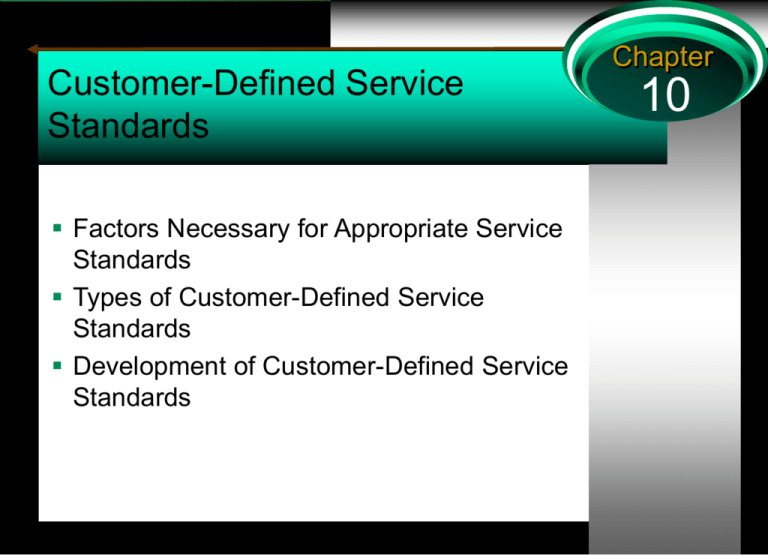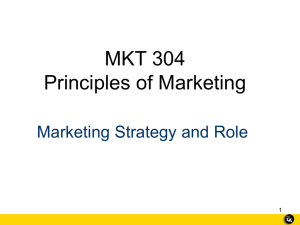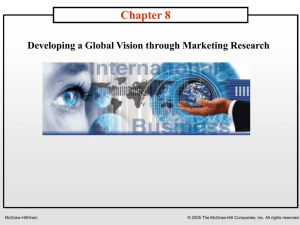
Customer-Defined Service
Standards
Factors Necessary for Appropriate Service
Standards
Types of Customer-Defined Service
Standards
Development of Customer-Defined Service
Standards
Chapter
10
Exhibit 10.1
Examples of Hard Customer-Defined Standards
McGraw-Hill/Irwin
© 2006 The McGraw-Hill Companies, Inc. All rights reserved.
Exhibit 10.2
Examples of Soft Customer-Defined Standards
McGraw-Hill/Irwin
© 2006 The McGraw-Hill Companies, Inc. All rights reserved.
Customer Defined Standards
Standardization vs Customization
Formal Targets
Specific Behaviors
Individual
Departments
Customer Defined Standards
Hard Standards
Soft Standards
One-Time Fixes
McGraw-Hill/Irwin
© 2006 The McGraw-Hill Companies, Inc. All rights reserved.
Figure 10.2
AT&T’s Process Map for Measurements
Source: R. E. Kordupleski, R. T. Rust, and A. J. Zaharik, “Why Improving Quality Doesn’t Improve Quality (or Whatever Happened to Marketing?),”
California Management Review 35, no. 3 (Spring 1993).
McGraw-Hill/Irwin
© 2006 The McGraw-Hill Companies, Inc. All rights reserved.
Figure 10.6
Linkage between Soft Measures and Hard
Measures for Speed of Complaint Handling
10
9
SATISFACTION
8
Large Customers
7
6
Small Customers
5
4
3
2
1
0
2
4
6
8
12
16
20
24
WORKING HOURS
McGraw-Hill/Irwin
© 2006 The McGraw-Hill Companies, Inc. All rights reserved.
Customer-Driven Standards and
Measurements Exercise
Service Encounter
Customer Requirements
Measurements
Service
Quality
McGraw-Hill/Irwin
© 2006 The McGraw-Hill Companies, Inc. All rights reserved.
Figure 10.3
What Customers Expect:
Getting to Actionable Steps
Satisfaction
Relationship
Dig
deeper
Value
Solution Provider
Reliability
Assurance
Responsiveness
Requirements: Diagnosticity:
Abstract
Low
General
concepts
Empathy
Tangibles
Price
Dimensions
Delivers on time
Returns calls quickly
Knows my industry
Dig
deeper
Dig
deeper
Attributes
Delivers by Wednesday
Returns calls in two hours
Knows strengths of my
competitors
Behaviors
and actions
Concrete
McGraw-Hill/Irwin
High
© 2006 The McGraw-Hill Companies, Inc. All rights reserved.
Figure 10.4
Process for Setting Customer-Defined Standards
1. Identify existing or desired service encounter sequence
2. Translate customer expectations into behaviors/actions
3. Select behaviors/actions for standards
4. Set hard or soft standards
Measure by
audits or
operating data
Hard
5. Develop feedback mechanisms
Soft
Measure by
transactionbased surveys
6. Establish measures and target levels
7. Track measures against standards
8. Provide feedback about performance to employees
9. Update target levels and measures
McGraw-Hill/Irwin
© 2006 The McGraw-Hill Companies, Inc. All rights reserved.
2. Translate customer expectations into
behaviors/actions
Actions/behaviors that are relevant to customer
Actions/behaviors that need improvements
Actions/behaviors that are improveable
Employee buy-in
Future based
Realistic
McGraw-Hill/Irwin
© 2006 The McGraw-Hill Companies, Inc. All rights reserved.
Figure 10.4
Process for Setting Customer-Defined Standards
1. Identify existing or desired service encounter sequence
2. Translate customer expectations into behaviors/actions
3. Select behaviors/actions for standards
4. Set hard or soft standards
Measure by
audits or
operating data
Hard
5. Develop feedback mechanisms
Soft
Measure by
transactionbased surveys
6. Establish measures and target levels
7. Track measures against standards
8. Provide feedback about performance to employees
9. Update target levels and measures
McGraw-Hill/Irwin
© 2006 The McGraw-Hill Companies, Inc. All rights reserved.
Figure 10.5
Importance/Performance Matrix
McGraw-Hill/Irwin
© 2006 The McGraw-Hill Companies, Inc. All rights reserved.






